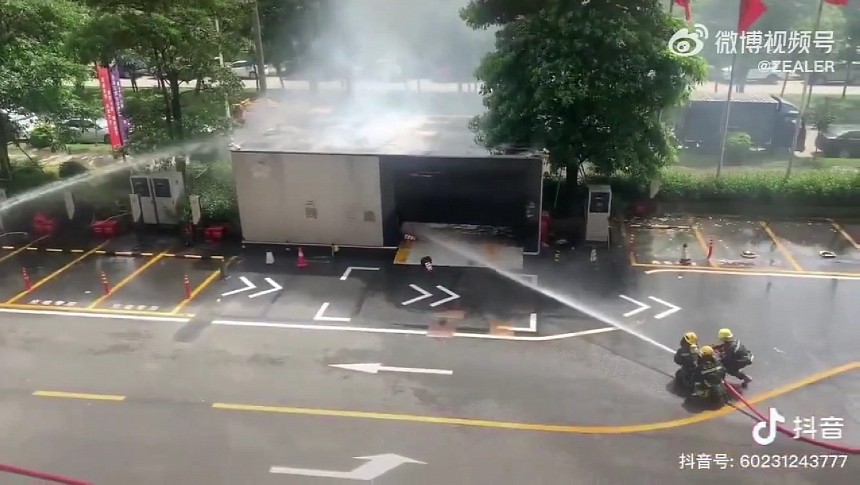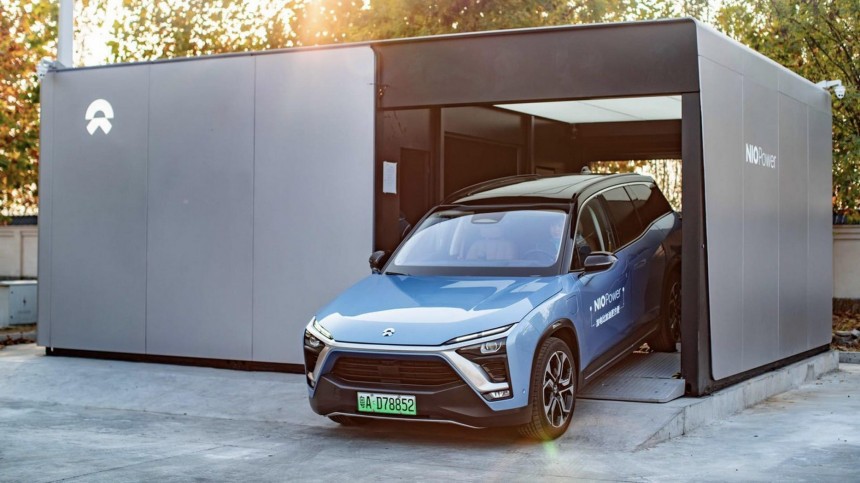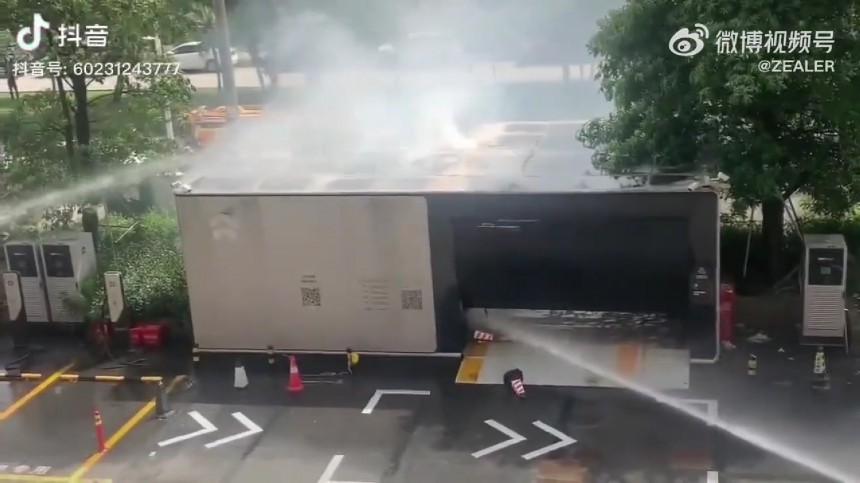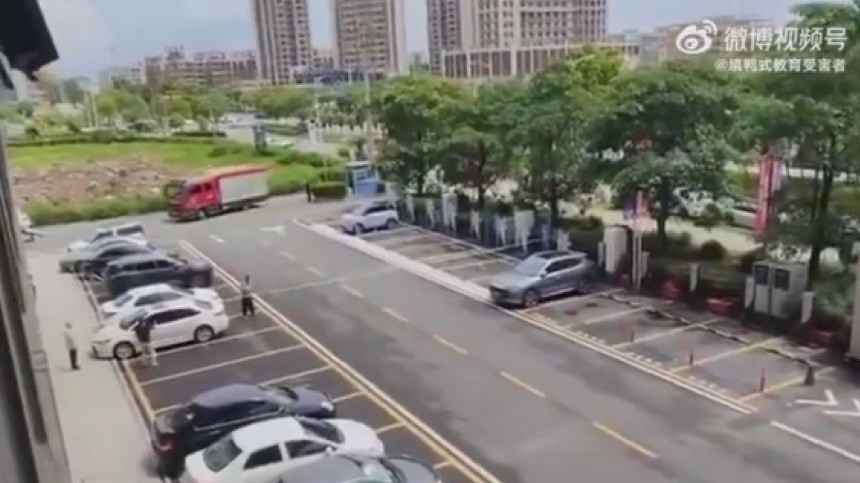NIO has just given an interesting and involuntary example of what may happen if anything goes wrong with its battery packs and swapping system. On June 25, a Power Swap 2.0 station saved a user from losing their BEV but did not prevent the component from presenting a thermal runaway. In fact, the first reports show it may even have made it worse: the station allegedly put the damaged battery pack to charge, which would have provoked a blaze.
The story emerged on Weibo and was quickly shared by our colleagues from CarNewsChina. According to the first reports on the Chinese social media, a NIO driver was warned that the battery pack in their car had been damaged and that they should go to a Power Swap station as soon as possible. They followed the instructions and drove to a second-generation swapping station in Jiangmen, close to Hong Kong and Macau. The company is about to deploy the third generation of these Power Swap stations (PSSs), but at least it does not have any first-generation units still taking care of its cars.
NIO users could feel reassured about this if the story ended here. After all, being able to determine whether the battery pack has a problem in real time is a great safety measure. Advising the involved customers to get them replaced immediately is probably what spared this driver from experiencing the fire with their car – eventually with them or their families inside it. However, that is just the nice part of this tale.
At about 2 PM local time – about 10 minutes after the driver who replaced the damaged battery pack left the station – a lot of smoke started pouring out from the Power Swap station. Firefighters arrived quickly and apparently managed to kill the flares. The information we have so far is that the station contained 13 battery packs: 8 regular ones and 5 hybrid components, which are composed of lithium iron phosphate (LFP) cells and ternary batteries. It is similar to what Our Next Energy (ONE) intends to do with the Gemini battery pack, but they have at least two major differences. The first is that NIO's ternary cells are NMC or NCA batteries. ONE does not want to see nickel and cobalt combined in its battery packs because it considers that match dangerous. The other is that all cells in the NIO battery pack work at the same time, while the manganese-rich anode-free cells on the Gemini only act to extend the range.
Everything being told about the fire is coming from social media. NIO has yet to address what happened and confirm if the facts really unfolded that way. One thing I would love to know is if the damaged battery pack was actually charged after it was removed. That is allegedly what caused the blaze, even if a damaged battery pack could catch fire without any other interference. Just check puncture tests performed with several kinds of cells, and you'll understand what I am talking about. These videos show that ternary batteries explode, while LFP cells can emit smoke in some cases. In others, it remains surprisingly unaffected, like in the video embedded below. However, that is not inherent to the chemistry. There are reported cases of LFP cells catching fire.
If the damaged battery pack was indeed charged, that is a massive safety failure from NIO. After all, the swap station could have other customers inside when the fire broke. If that did not occur, it is urgent to hear from NIO what it does in such cases. Is there a compartment for damaged cells to be safely stored inside the Power Swap stations? If there isn't anything of this kind, what is the company's emergency plan for similar situations that may happen in the future? NIO probably never faced anything like this, which is no excuse for not having a plan to deal with such emergencies.
Unofficial reports declare that the firefighters that extinguished the blaze confirmed it started in the defective battery pack. I'd try to contact the Chinese authorities in Jiangmen if they answered, but they are predictably not very open about anything. Chinese readers could try to help us if they could beat the government's firewall and read our articles. That said, only NIO will be able to answer all the doubts this episode brought up – and it should do that as soon as possible.
NIO champions a system that makes BEVs more convenient with battery pack swapping. Thanks to that, they can make road trips with very short stopping times whenever Power Swap stations are on their route. Not having to purchase a battery pack also makes NIOs more affordable and gives customers peace of mind that their BEVs will keep running for way more time than regular ones. They are not limited to the battery pack's expiry date or their mileage. That's something that Tesla owners are getting in touch with more frequently now that their BEVs are out of warranty and presenting the BMS_u029 error.
Even with all these advantages, it is pretty concerning that a damaged or defective battery pack can cause a fire in a storage station that can have up to 13 units. The Power Swap 3.0 stations can hold 21 battery packs. As I said, NIO is dealing with BEV limitations in a laudable way, but it owes its customers an explanation about emergencies like this one.
NIO users could feel reassured about this if the story ended here. After all, being able to determine whether the battery pack has a problem in real time is a great safety measure. Advising the involved customers to get them replaced immediately is probably what spared this driver from experiencing the fire with their car – eventually with them or their families inside it. However, that is just the nice part of this tale.
Everything being told about the fire is coming from social media. NIO has yet to address what happened and confirm if the facts really unfolded that way. One thing I would love to know is if the damaged battery pack was actually charged after it was removed. That is allegedly what caused the blaze, even if a damaged battery pack could catch fire without any other interference. Just check puncture tests performed with several kinds of cells, and you'll understand what I am talking about. These videos show that ternary batteries explode, while LFP cells can emit smoke in some cases. In others, it remains surprisingly unaffected, like in the video embedded below. However, that is not inherent to the chemistry. There are reported cases of LFP cells catching fire.
Unofficial reports declare that the firefighters that extinguished the blaze confirmed it started in the defective battery pack. I'd try to contact the Chinese authorities in Jiangmen if they answered, but they are predictably not very open about anything. Chinese readers could try to help us if they could beat the government's firewall and read our articles. That said, only NIO will be able to answer all the doubts this episode brought up – and it should do that as soon as possible.
Even with all these advantages, it is pretty concerning that a damaged or defective battery pack can cause a fire in a storage station that can have up to 13 units. The Power Swap 3.0 stations can hold 21 battery packs. As I said, NIO is dealing with BEV limitations in a laudable way, but it owes its customers an explanation about emergencies like this one.





























